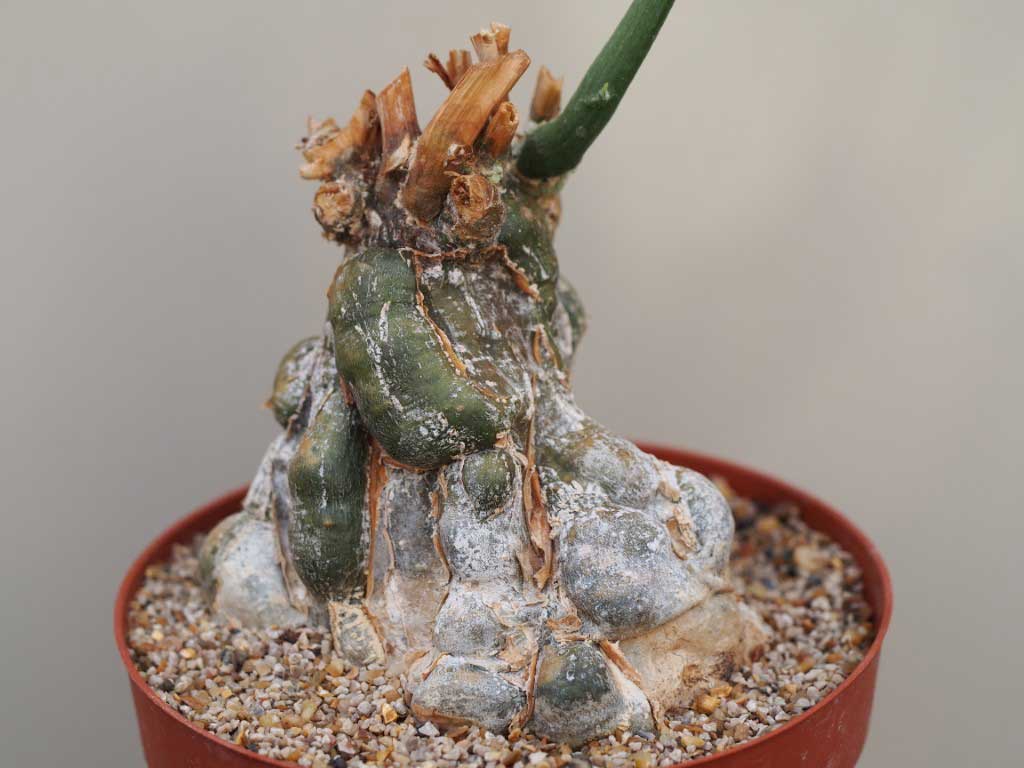My plant collection is very mixed, with both cacti and other succulents in all shapes and sizes, but one group of plants that I particularly like are the caudiciforms. I have chosen as my plant of the month Cephalopentandra ecirrhosa (synonym Coccinia ecirrhosa). This a member of the cucumber family (Cucurbitaceae) and it can be found in Ethiopia, Kenya, Somalia and Uganda (Fig. 1).

It forms a volcano shaped caudex with a very knobbly texture, reminiscent of the shapes that dripping candle wax can create. The caudex can grow to 60cm diameter and weigh up to 10kg. It is dormant during periods of drought, extreme cold or extreme heat but when given the correct growing conditions it produces fast growing vines up to one metre, bearing large, pretty yellow flowers, followed by orange fruit.
It is one of my favourite caudiciforms because I find it easy to grow, because it produces a large caudex relatively quickly and because of the wonderfully textured, tactile surface. Another reason is that the stems only grow one metre in a season. Some of the Cucurbitaceae caudiciforms I grow, for example Kedostris Africana, can grow 5 or 6 metres in one season. For these I put the pots on the greenhouse floor and drop a wire from the roof for the vines to climb up, but by mid-summer they are trying to grow out of the roof vents. With only a one metre vine, I can keep the Cephalopentandra pots on top of a bench and train the stems up a wire. This means that the caudex can be seen and appreciated more easily when it is at waist level.
I grow the plants in the warmer section of my greenhouse which has a minimum temperature of 13°C in winter. In October I stop watering the plants and allow the vines to turn yellow then die back. The pots can be stored under the benches for winter, as they do not need light when they have no leaves. I start watering again in mid-March to bring them into growth, or earlier if the plants start growing before watering. Fig. 2 shows of one of my plants, and it is already producing the first green shoot in late January!

The plants suffer from the normal greenhouse pests. You need to watch out for mealy bugs which can lay their eggs in the fissured bark. The soft new leaves are also prone to red spider mite. I use biological control in the greenhouse for spider mite, as I have too many plants to make spraying with SB Plant Invigorator or Neem oil practical. I water and feed well in the summer when the plants are in active growth.


I have five Cephalopentandra ecirrhosa plants, all from a packet of five seeds I bought a few years ago. The caudexes are currently between 10 and 12cm wide at the base, but I have not yet got my plants to fruit. They are dioecious, so you need a male plant and a female plant in flower at the same time. I have one plant (male) that flowers all summer, but the other four plants have not started flowering yet and just produce green vines. With four still to reach maturity and flower each year, the chances of at least one being female are hopefully high. I would be very interested to hear from anybody else who grows these, whether they get fruits and viable seeds.
Ron Crawford
No part of this article may be reproduced without permission. Copyright BCSS & the Author 2022
